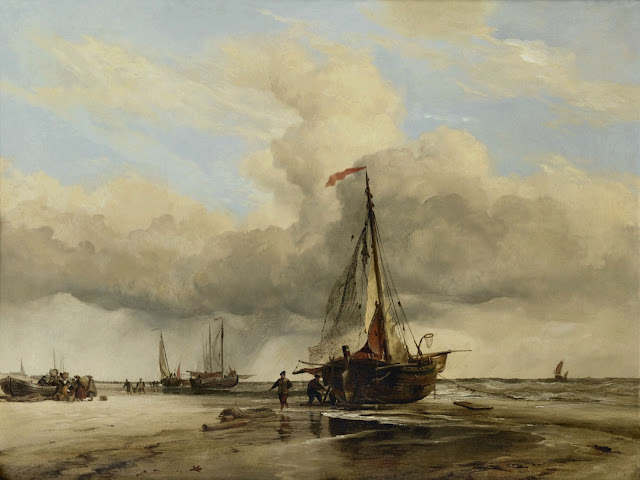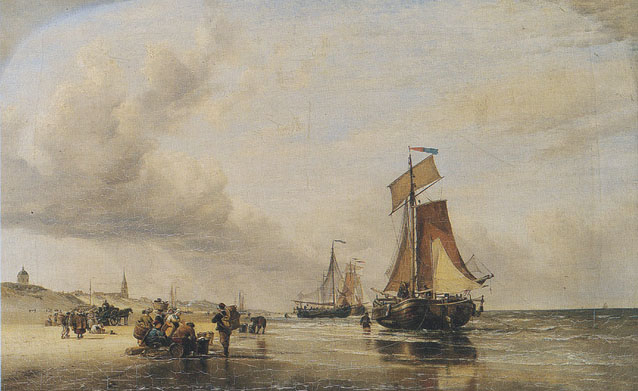Edward William Cooke (1811–1880) was an English landscape and marine painter. He was born in London, the son of well-known line engraver George Cooke; his uncle, William Bernard Cooke (1778–1855), was also a line engraver of note, and Edward was raised in the company of artists. He was a precocious draughtsman and a skilled engraver from an early age, displayed an equal preference for marine subjects and published his "Shipping and Craft" when he was 18, in 1829. Cooke began painting in oils in 1833 and first exhibited at the Royal Academy and British Institution in 1835.
He went on to travel and paint with great industry at home and abroad, indulging his love of the 17th-century Dutch marine artists with a visit to the Netherlands in 1837. He returned regularly over the next 23 years, studying the effects of the coastal landscape and light, as well as the works of the country’s Old Masters, resulting in highly successful paintings. He went on to travel in Scandinavia, Spain, North Africa and, above all, to Venice. In 1858, he was elected into the National Academy of Design as an Honorary Academician.
He also had serious natural history and geological interests, being a Fellow of the Linnean Society, Fellow of the Geological Society and Fellow of the Zoological Society, and of the Society of Antiquaries. In the 1840s he helped his friend, the horticulturist James Bateman to fit out and design the gardens at Biddulph Grange in Staffordshire, in particular the orchids and rhododendrons. His geological interests in particular led to his election as Fellow of the Royal Society in 1863 and he became a Royal Academician the following year. In 1842 John Edward Gray named a species of boa, Corals cookii, in Cooke's honour.
This is part 4 of 11 on the works of Edward William Cooke:
 |
| 1840 Heidelberg - Gate from the Town pencil 17.2 x 12.4 cm National Maritime Museum, London |
 |
| 1840 Off the Port of Havre oil on canvas 167.5 x 214 cm Bury Art Museum, UK |
 |
| c1840 Shipping off Portsmouth oil on canvas 42 x 62.7 cm Portsmouth Museums and Visitor Service, UK |
 |
| 1841 Elizabeth Castle, Jersey, from the Causeway: low water oil on canvas 103.5 x 142 cm |
 |
| 1841 (or before) Mont St Michel - Peasants returning to Pontorson on the approach of the tide oil on canvas 105.1 x 142.9 cm |
 |
| 1842 Boulogne fish market 8 October 1842 pencil 7.2 x 12.1 cm National Maritime Museum, Greenwich, London |
 |
| 1842 Dutch trawlers drying their sails and nets on the beach at Scheveningen oil on canvas 45.7 x 61 cm |
 |
| 1842 Mont St Michel-Shrimpers oil on canvas 97 x 142.5 cm Art Gallery of New South Wales, Sydney, Australia |
 |
| 1842 The fish market, Boulogne 8 October 1842 pencil 17.1 x 12.1 cm National Maritime Museum, Greenwich, London |
 |
| 1842c Dutch Boats Beating into the Scheldt oil on canvas 43.2 x 53.5 cm Dudley House, Liverpool, UK |
 |
| 1843 Dutch coastal scene with a Koff and other shipping at anchor, and fisherfolk on the beach at Scheveningen oil on canvas 42.8 x 67.6 cm |
 |
| 1843 Dutch Boats in a Calm oil on mahogany panel 42.2 x 68.6 cm Tate, London |
 |
| n.d. Dutch Boats in a Calm engraving by Thomas Jeavons after Cooke Photo © President and Fellows of Harvard College |
 |
| 1843 Fishing vessel ashore 1 September 1843 pencil 10.5 x 17.8 cm National Maritime Museum, Greenwich, London |
 |
| 1843 Fishing vessel ashore with mast lowered for repairs 21 August 1843 pencil 11.1 x 18 cm National Maritime Museum, Greenwich, London |
 |
| 1843 Shrimper 30 August 1843 pencil 8.3 x 9.4 cm National Maritime Museum, London |
 |
| 1844 Antwerp from the Scheldt, morning oil on canvas 53 x 122 cm |
 |
| 1844 Dordrecht in the morning oil on canvas 68.5 x 99 cm |
 |
| 1845 A Calm day on the Scheldt oil on canvas 58.5 x 89 cm |
 |
| 1845 Cactus Opuntia, Monaco oil on board 24.4 x 34.5 cm |
 |
| 1845 Dutch fishing craft off Fort Lillo, mouth of the Scheldt oil on panel 31.8 x 40 cm |
 |
| n.d. Dutch Fishing Craft off Ransdorp near Amsterdam details not found |
 |
| 1845 Dutch fishing craft off Fort Lillo, mouth of the Scheldt oil on panel 31.8 x 40 cm |
 |
| 1845 Finale, from the tunnel October 7 1845 pencil 10.1 x 12 cm National Maritime Museum, London |
%20V&A,%20London.jpg) |
| 1845 Fishing boats on the beach at Nice, with Antibes in the distance pencil 3.7 x 11.7 cm (approx) V&A, London |
 |
| 1845 Fort of Finale 6 October 1845 pencil 7.2 x 12.3 cm National Maritime Museum, Greenwich, London |
 |
| 1845 Off the Needles, Isle of Wight oil on canvas 69.9 x 90.2 cm Yale Center for British Art, New Haven, CT |
 |
| 1845 St Remo 19 September 1845 pencil 12.1 x 17.1 cm National Maritime Museum, London |
 |
| 1845 The Lantern & part of Arsenal, Genoa 29 October 1845 pencil 23.5 x 21 cm |
 |
| 1845 The Pont St. Bénezet, Avignon pencil on wove paper 13.4 x 21.2 cm Royal Academy of Arts, London |
 |
| 1845-46 Temple of Vesta, Rome pencil 10.8 x 17.9 cm National Maritime Museum, Greenwich, London |
 |
| 1846 A Roman Cart pencil on wove paper 11.2 x 17.2 cm Royal Academy of Arts, London |
 |
| 1846 Santa Maria della Navicella pencil on wove paper 10.8 x 17.5 cm Royal Academy of Arts, London |
 |
| 1846 Salerno 28 May 1846 pencil 10.9 x 18.1 cm National Maritime Museum, London |
 |
| 1846 Rome, evening: St Peter's and the Castel Sant' Angelo from the Tiber pencil 10.5 x 16.9 cm National Maritime Museum, Greenwich, London |
 |
| 1846 Roman wine cart pencil on off-white wove paper 16 x 10 cm Royal Academy of Arts, London |
 |
| 1846 Olive wood, Tivoli pencil on off-white wove paper 10.7 x 17.8 cm Royal Academy of Arts, London |
%20Pietro%20Vincoli,%20(Rome)%2017%20March%201846%2011%20x%2017.8%20cm%20National%20Maritime%20Museum,%20Greenwich,%20London.jpg) |
| 1846 From the steps of the church of (St) Pietro Vincoli, (Rome) 17 March 1846 pencil 11 x 17.8 cm National Maritime Museum, Greenwich, London |
 |
| 1846 Fragments of the Temple of the Sun in the Colonna Garden pencil on wove paper. 10.8 x 17.7 cm Royal Academy of Arts, London |
 |
| 1846 English Academy Rome life study 13 January 1846 pencil 41.8 x 29.2 cm National Maritime Museum, Greenwich, London |
 |
| 1846 English Academy Rome life study 13 January 1846 pencil 41.6 x 29.2 cm National Maritime Museum, Greenwich, London |
 |
| 1846 English Academy Rome life study 6 January 1846 pencil 41.7 x 28.5 cm National Maritime Museum, Greenwich, London |
 |
| 1846 Tasso's Oak, Rome pencil 10.9 x 18.1 cm National Maritime Museum, Greenwich, London |
 |
| 1846 The Capucin Convent, Amalfi oil on paper laid down on canvas 29.2 x 44.3 cm |
 |
| 1846 The garden of the Convent of St. Bonaventure, Rome pencil on wove paper 18 x 10.8 cm Royal Academy of Arts, London |
 |
| 1846 The Ponte Quattro Capri from the Isola Tiberina, Rome pencil 10.8 x 17.5 cm Royal Academy of Arts, London |
 |
| 1846 The Villa Giustinian pencil on cream wove paper 8.9 x 17.9 cm Royal Academy of Arts, London |
 |
| 1846 Two studies of carts, Monte Citorio, Rome pencil on off-white wove paper 12.8 x 10.7 cm Royal Academy of Arts, London |
 |
| 1846 Vesuvius and Castel del Ovo, seen from Villa Cedroni, Posillippo oil on paper laid on board 18.2 x 26.2 cm |
 |
| before 1847 Mount Vesuvius, Catalan and Paranzella oil on canvas 36.9 x 57.8 cm |
 |
| 1847 Feluccas on the Beach at Oneglia, Italy oil on canvas 46 x 75.5 cm |
 |
| 1848 A Dutch Calm oil on canvas 45.7 x 91.4 cm |
 |
| 1848 A Dutch Calm, Zuider Zee fishing craft oil on canvas 45.7 x 91.4 cm |
 |
| 1848 Breaming a Calais Lugger at low water oil on board 45 x 61 cm Walker Art Gallery, Liverpool, UK |
 |
| 1848 Dutch Yachting on the Zuider Zee oil on canvas 61 x 100.5 cm National Maritime Museum, London |
 |
| 1848 Off the Coast of Leghorn oil on canvas 104.5 x 143.5 cm Cartwright Hall Art Gallery, Bradford, UK |
 |
| 1848 Shipping on the Ij oil on panel 10.9 x 24.8 cm The Ashmolean Museum of Art and Archaeology, Oxford, UK |
 |
| 1849 Barton Grange 24 September 1848 pencil 11.8 x 17.3 cm National Maritime Museum, Greenwich, London |
 |
| 1849 Dutch Pilots warping their craft out off harbour in rough weather oil on canvas 91 x 127 cm |
 |
| 1849 Salerno, Italy oil on canvas 61 x 99 cm Guildhall Art Gallery, London |
No comments:
Post a Comment
Note: only a member of this blog may post a comment.